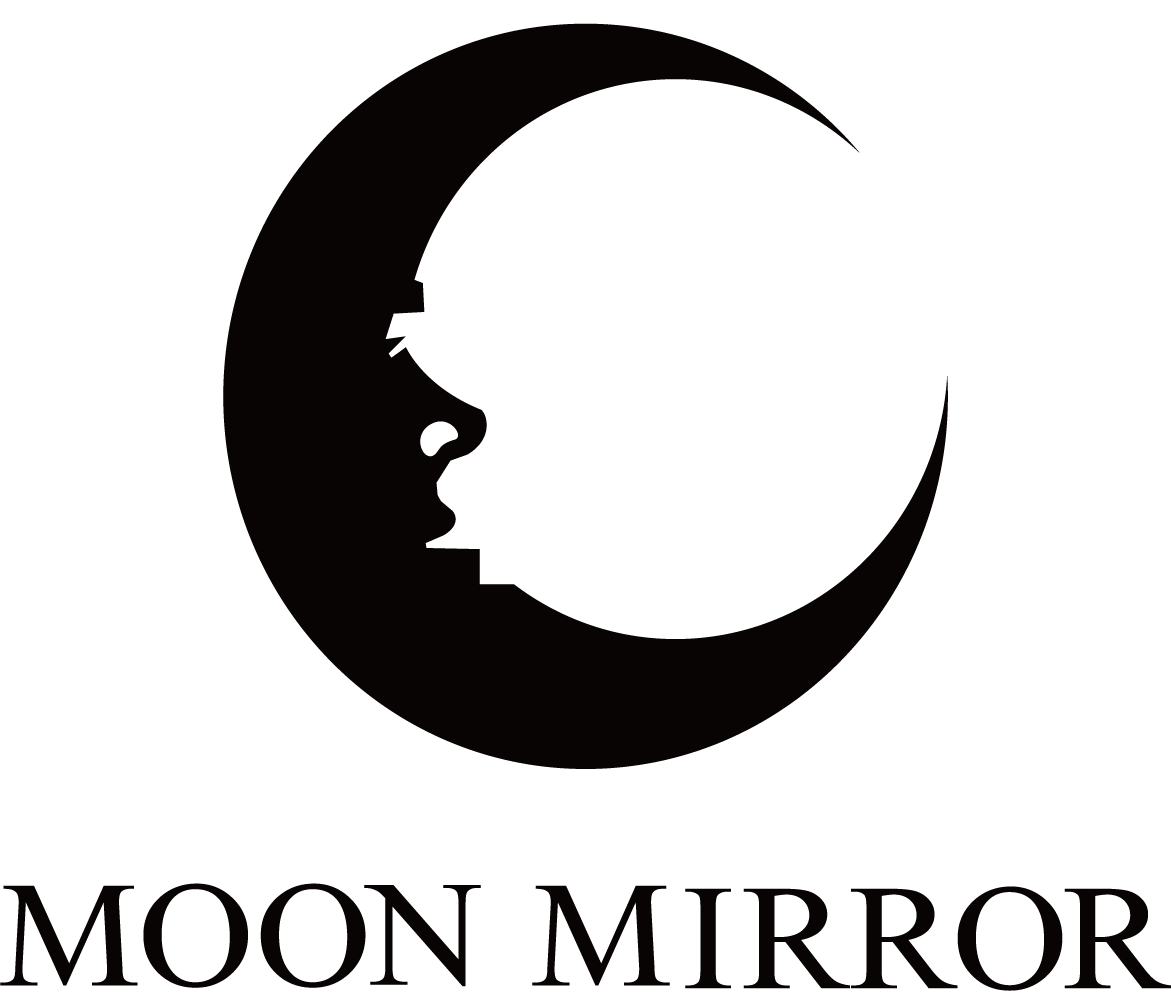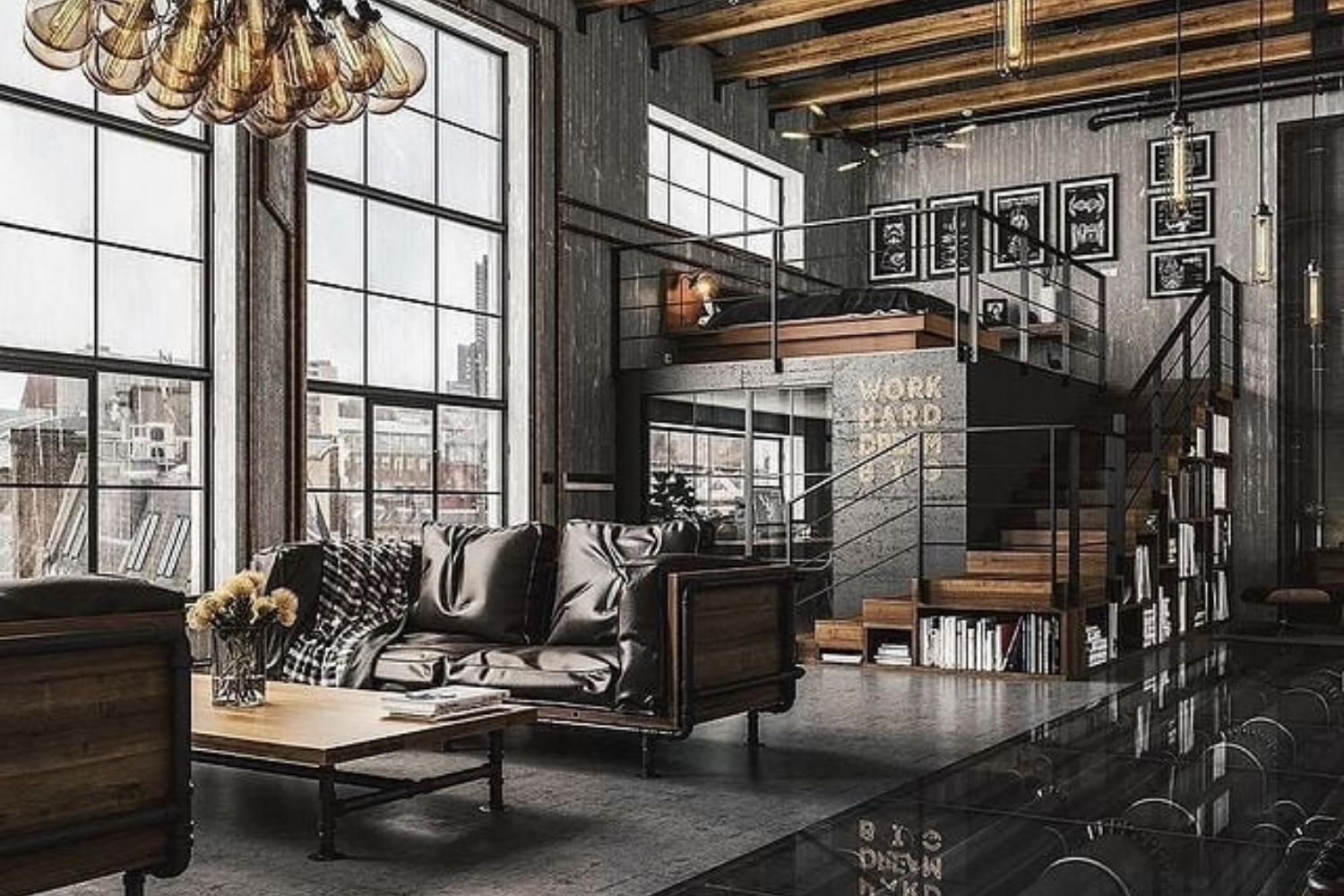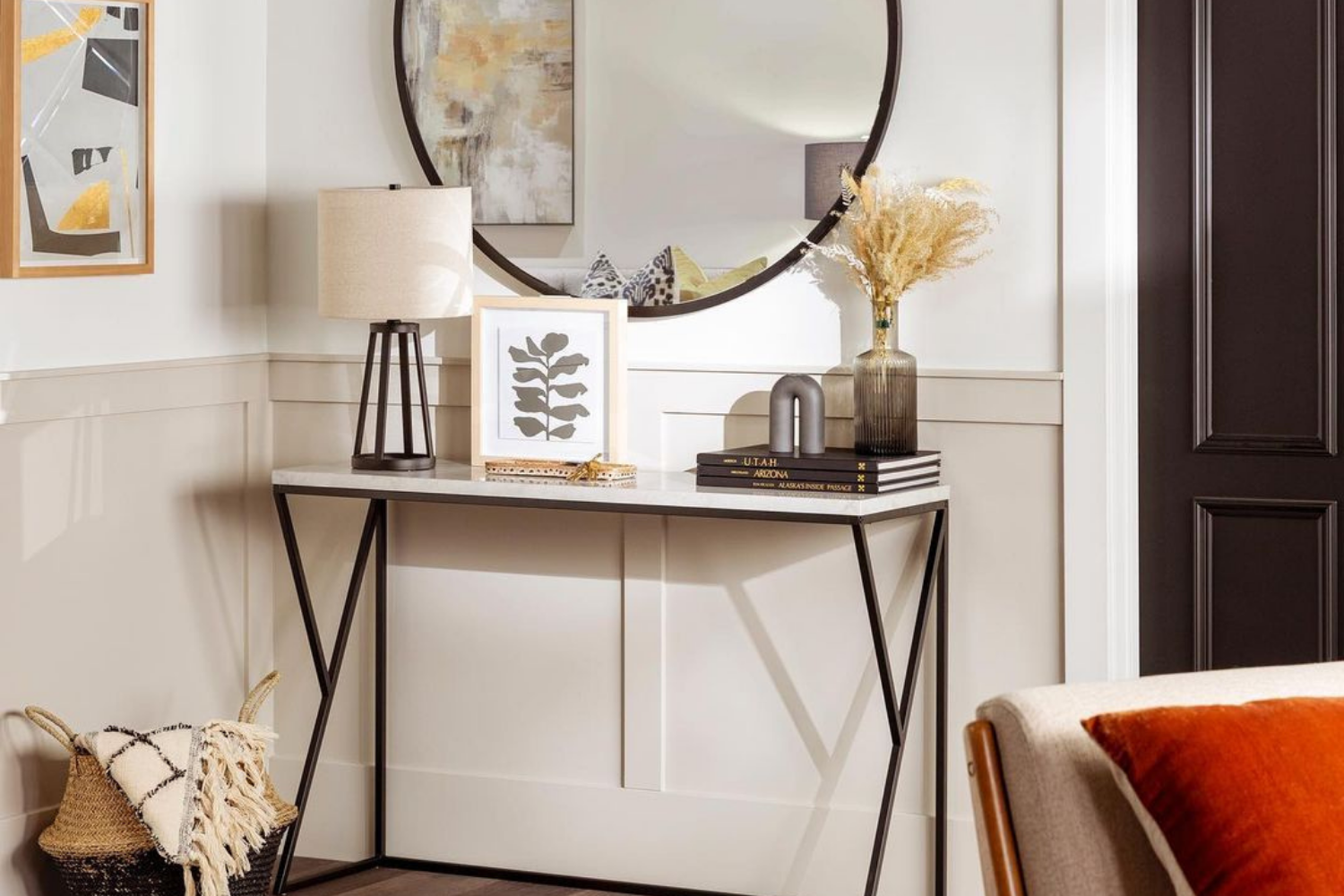:max_bytes(150000):strip_icc():format(webp)/industrial-style-living-rooms-20-amy-bartlam-24-1400accc944a4eefbebb381d066a1b5a.png)
Curating an industrial living room can be a challenge. After all, aren’t living rooms supposed to be cozy? And isn’t industrial design one of the sleekest, most function-focused disciplines around? But the truth is, there are plenty of ways to bridge the gap between the welcoming comfort of a living room and the crisp, clean style that characterizes industrial design. You can strike that balance whether you’ve moved into an industrial space or a completely classic one.
To jumpstart your design process, we’ve rounded up 23 ridiculously chic industrial-style living rooms—and cited a design idea worth stealing from each of them. Get ready to transform your traditional living room into a sleeker space—or to give your industrial loft the warm, cozy touches every living room needs.
Stock Up on Sleek Furniture
:max_bytes(150000):strip_icc():format(webp)/industrial-style-living-rooms-1-katie-martinez-44th-2-72f10e44fd0847569296af95bdd14f3c.png)
Industrial design is a minimalist discipline, characterized by sturdy materials and low-profile silhouettes. So, one of the easiest ways to craft an industrial living room is to stock up on sleek industrial furniture. Look for pieces made from rugged materials, like metal and wood, and prioritize crisp lines wherever you can. Remember, coziness isn’t off the menu entirely—there are plenty of comfy and industrial lounge chairs out there.
Embrace Rugged Functionality
:max_bytes(150000):strip_icc():format(webp)/industrial-style-living-rooms-2-amy-bartlam-23-e940ba7fa1c44076be9b35efdb04730f.png)
A punching bag would be out of place in most living rooms, but in an industrial living room, it should fit right in. Why? Industrial design is all about functionality in its most unapologetic form. You’d leave pipes, wires, and beams exposed, so why not leave your exercise equipment exposed, too?
Invest in Metal Shelves
:max_bytes(150000):strip_icc():format(webp)/industrial-style-living-rooms-3-devon-grace-lakeview-191efe98cf3a4755b9404097190d1ecc.jpeg)
Pipe shelves are having a moment, and they’d look great in any industrial-style living room. For the uninitiated, pipe shelves are exactly what they sound like: shelves crafted from metal pipes. Even if you don’t want to go that rugged, more polished metal shelves should get the job done. These sleek materials will add texture and durability to any room—making your space more industrial and more efficient.
:max_bytes(150000):strip_icc():format(webp)/pipe-shelves-65f7c76288824531a4f12213e7894130.jpg)
Play With Negative Space
:max_bytes(150000):strip_icc():format(webp)/industrial-style-living-rooms-4-yael-weiss-west24-c9ba4c48d3d0488088fa153cafd6bb35.jpeg)
Most industrial interiors are wide, open spaces characterized by high ceilings and very few walls. This can pose a design challenge: how on earth do you fill all the space? But the answer is simple: don’t. Instead, cluster your décor together and leave pockets of your space completely empty. This is a great way to exaggerate the openness of your space or to make a classic space feel more industrial.
Favor Graphic Art
:max_bytes(150000):strip_icc():format(webp)/industrial-style-living-rooms-5-mary-patton-93500bcf92de4e76b416aa500c6501c3.jpeg)
Art can be a great way to bring your space together. And if you’re crafting an industrial-style interior, consider sticking to graphic art wherever you can. The genre shares similarity with industrial design—with its crisp lines, solid tones, and nods to commercialism, it should make a fitting choice for any industrial space.
Mimic the Look of Exposed Lighting
:max_bytes(150000):strip_icc():format(webp)/industrial-style-living-rooms-6-devon-grace-illume-2-4f03e580dba44ee09b7fcdc1ee2fec20.jpeg)
Many industrial interiors boast unfinished ceilings where lights, wires, and beams have been left completely exposed. If your ceiling doesn’t look like this, don’t worry—you can replicate the look with your lighting.
Favor flush mounts, which jut out from the ceiling, over recessed lighting, and use pipe-lined fixtures or extra-long pendant lights to make your space look less pristine.
Keep Your Palette Streamlined
:max_bytes(150000):strip_icc():format(webp)/industrial-style-living-rooms-8-tyler-karu-overlook-c0f28fca597f4d3f98fa9659f237a7e1.jpeg)
Industrial design isn’t just about streamlined silhouettes—it’s about a streamlined approach to design in general. Keep your palette as sleek and pared-down as the rest of your space. Of course, this doesn’t have to mean forgoing color entirely. Just pick a couple of colors and stick with them.
Layer Different Metals
:max_bytes(150000):strip_icc():format(webp)/industrial-style-living-rooms-9-mary-patton-3-e90fae03370d4c4a88a481098530b5f8.jpeg)
Metal is one of the most commonly used materials in any industrial design scheme, and remember, your metals don’t have to match. Pair a shiny silver floor lamp with a glossy copper planter and throw some rusted stainless steel into the mix, too. In industrial design, you’ll find metals ranging from sleek to matte to rugged, and since they play so well together, there’s no need to stick to just one.
Spring for a Statement Ceiling
:max_bytes(150000):strip_icc():format(webp)/industrial-style-living-rooms-10-katie-martinez-melody-lane2-2b56ac7cb8d842cb844ba385b4c446c6.png)
Industrial ceilings often make a statement even when they’re not trying to. Why? Leaving a ceiling unfinished is an out-of-the-box choice, and out-of-the-box choices demand attention.
Thankfully, tearing out your finished ceiling isn’t your only option. Instead, you can nod to the idea of an unfinished ceiling by lining your ceiling with wood paneling, exposed wood beams, or some other structural material.
Load Up on Task Lighting
:max_bytes(150000):strip_icc():format(webp)/industrial-style-living-rooms-11-katie-hodges-north-sunset-12-76d95ad7ee674294885d4d22c4411ac0.png)
There are many different lighting options out there, and if you’re designing an industrial interior, task lighting is about to become one of your favorites. Task lighting is lighting dedicated to a specific task (think: a reading light or a desk lamp). And since industrial design is all about functionality, task lighting will make a natural addition to any industrial living room.
Leave Room for White Space
:max_bytes(150000):strip_icc():format(webp)/industrial-style-living-rooms-12-devon-grace-new-gallery-9e8efe5cc68e41c5876455a6327f93f0.jpeg)
When designing an industrial interior, you’ll want to embrace negative space both at the macro and micro levels. Try to build blank space into your shelves the same way you’d build blank space into your furniture layout. Combined, these choices should leave your space feeling vaster, more open—and of course, more industrial.
Soften Things Out With a Coat of Paint
:max_bytes(150000):strip_icc():format(webp)/industrial-style-living-rooms-13-anne-sage-modern-luxe-living-2-8d9efd97f73b4e2fb31e3b689e017dfc.jpeg)
Brick walls, metal pipes, and wooden beams can make dynamic additions to any industrial space. But, if you find them too cold or harsh, consider painting them a soft neutral, like white. The coat of paint will mellow out the fixtures without disguising them entirely—giving you a balance between soft comfort and industrial flair.
Embrace Imperfection
:max_bytes(150000):strip_icc():format(webp)/industrial-style-living-rooms-14-liljencrantz-design-marie-hill-2-666d31a242604879a47a502af31c7301.jpeg)
Function is key in industrial design, so resist the urge to keep your place as pristine as possible. That doesn’t mean leaving your space an absolute mess, but it could mean letting a smoke stain accumulate in your fireplace.
Add Pops of Coziness
:max_bytes(150000):strip_icc():format(webp)/industrial-style-living-rooms-15-sarah-fultz-6ec55d9bf8ac4dddacf4b84034345f24.jpeg)
Comfort may seem out of place in an industrial design scheme. But the truth is, the two aren’t mutually exclusive. If you’ve loaded up on industrial furniture, you can certainly get away with a couple of neutral rugs, and you can always soften out a chair with some sleek leather cushions.
Highlight Your Windows
:max_bytes(150000):strip_icc():format(webp)/industrial-style-living-rooms-7-becca-interiors-soho-loft-b6d95104be2646fdac25702c8ace29e6.jpeg)
Window-lined walls are a classic feature of many industrial interiors. If you’ve been blessed with enormous windows, draw attention to them by placing large décor nearby. A massive plant is sure to highlight the scale of an even more massive window.
If you’re working with a smaller window, pull the eye to it using a bold piece of furniture that can rest just below the window sill.
Turn Structures Into Statement-Makers
:max_bytes(150000):strip_icc():format(webp)/industrial-style-living-rooms-16-tyler-karu-eastern-prom-fbacf5d8dbe14bf083f8823cd83059be.jpeg)
When working with an industrial space, it can be tempting to ignore rugged structures like columns, beams, and pipes. But, what if you made these structural elements focal points in your space? An exposed metal fireplace may seem like a buzzkill until you build your entire living room around it. By incorporating the structure into your décor scheme, you can transform it into a statement-maker.
Mix and Match Aesthetics
:max_bytes(150000):strip_icc():format(webp)/industrial-style-living-rooms-17-anne-sage-mix-and-match-00142c92361445a6a7e356b8a322345f.jpeg)
When designing a space, you don’t have to commit to just one aesthetic. Use industrial design as your starting point, and mix in other pieces as you see fit. Snag a contemporary couch, layer a couple of plush rugs, and throw in a few earthy accents.
This may sound like a recipe for disaster. But since industrial design is so sleek, it can play incredibly well with other styles of décor.
Don’t Be Afraid to Go Dark
:max_bytes(150000):strip_icc():format(webp)/industrial-style-living-rooms-18-reagan-taylor-d0dc698d4562457184aa73b85d60988d.jpeg)
Dark colors can be daunting to decorate with, but industrial design wears them well. For one thing, the high ceilings that accompany many industrial interiors are unlikely to ever feel low or cramped. Even if your ceilings aren’t ridiculously high, darker shades like black, charcoal, or navy are sure to complement some of the rugged materials in your space.
Keep Your Floors Sleek
:max_bytes(150000):strip_icc():format(webp)/industrial-style-living-rooms-19-liljencrantz-design-villa-w-acf07755fa39415d890b2c2220ad3ad5.jpeg)
Your walls and your ceilings aren’t the only things that deserve attention—your floors do, too. If you want your floors to feel as industrial as possible, opt for something sleek—like dark hardwoods or cement. And remember, you can always soften things up with the addition of a low-profile rug.
Make the Most of Bare Walls
:max_bytes(150000):strip_icc():format(webp)/industrial-style-living-rooms-20-amy-bartlam-24-1400accc944a4eefbebb381d066a1b5a.png)
When your ceilings are high, you’ll end up with a lot of wall space to work with, and it can be tough to fill. So, scale up the size of your purchases accordingly. A massive work of art might overwhelm a smaller space, but in an industrial interior, it will fit right in. You can even DIY your own showstopper using a metal frame and some crisp white cloth.
Look for Opportunities to Add Texture
:max_bytes(150000):strip_icc():format(webp)/industrial-style-living-rooms-21-charlie-coull-lynden-bf3b281cbb314c2fbcb77a5a48d80620.jpg)
Industrial interiors may be about sleek materials and streamlined silhouettes, but that doesn’t mean they’re totally devoid of texture. Rugged materials like cement can feel very at home in an industrial design scheme, especially when used in the right contexts. If you’re in need of a material for a structural accent, consider choosing something with a little texture.
:max_bytes(150000):strip_icc():format(webp)/cement-fireplace-b99cdcaeae4941afaeca74d6d3d87181.jpeg)
Tear Out Your Ceilings
:max_bytes(150000):strip_icc():format(webp)/industrial-style-living-rooms-22-anne-sage-modern-luxe-living-680a280faa9b46d9b6e376aa52546195.jpeg)
If you didn’t inherit a space with exposed, unfinished ceilings, all hope isn’t lost. You can still tear out the ceilings you have. Now, this is a bold move so be sure it’s what you want to do before you do it. That said, it can be an effective way to extend low ceilings—and expose some of the industrial details in your space.
Invest in a Few Decisive Pieces
:max_bytes(150000):strip_icc():format(webp)/industrial-style-living-rooms-23-bespoke-only-brooklyn-heights-61ebf45cbb5140fbbcb2f82940d96d26.jpeg)
Crafting an industrial-style living room doesn’t have to be a matter of remodeling your space. Even a couple of striking pieces like a sleek table and a metal task lamp can leave your space feeling more industrial.
Mix a few industrial finds in with the pieces you already own and keep your living room feeling both cozy and sleek. Or, work your way to a fully industrial living room over time—little by little, and purchase by purchase.






















Laisser un commentaire
Ce site est protégé par hCaptcha, et la Politique de confidentialité et les Conditions de service de hCaptcha s’appliquent.